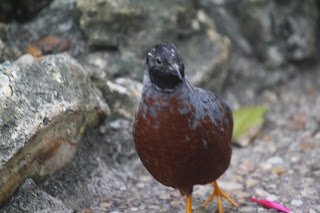Florida Museum of Natural History and Butterfly Rain Forest
University of Florida Cultural Plaza
SW 34th & Hull Road
Gainesville, FL 32611-2710
352-846-2000
School Tours: 352-273-2026
Group tours 352-273-2027
Parking: $4.00
General Admission FREE (donations appreciated)
Rainforest: $10.50 Adults,
Other Rates apply for children, Seniors, Students, Florida Residents and Museum members: ASK! (they are not posted)
Lynne and I went on another adventure. Between Brooksville and Lynne’s visit to our home, we had been together since for eight days. This particular adventure was to the Florida Museum of Natural History and Butterfly Rain Forest at University of Florida. What a beautiful place! Lynne has a love of butterflies and has been planting her garden with attracting butterflies in mind. It turns out that butterflies have a special talent for discerning color—better than man. Their discernment allows them to see many more hues and shades than we humans. So, the types and colors of flowers to woo butterflies become very important.
We had asked Steve to join us, but he did not. With his impatience, it was a good choice. He would have enjoyed it, but only for a few minutes.
After paying our parking fee, we hiked past the Art Museum where there were several outdoor monstrous sized sculptors. One particularly impressed me. That was the gigantic iron man hammering. The hammer was motorized, giving us the impression that he was, indeed, a hard- working man.
The Rainforest is part of the building of the Florida Museum of Natural History. So, one must enter through the front door of the museum. We entered and headed as directed to the right. One must go through two doors with high pressure air between (both entering and exiting). This is to prevent the loss of butterflies by their escaping. There is an incredible display of a bazillion butterflies all mounted (they die naturally as butterflies have a short life span) with the particular species with which they are a part. The colors are beyond words.
I learned so much. One thing that became quite evident is that many butterflies have different coloring on the top (which becomes the outer part of the wing when they have lighted on a plant or fruit) and a different color on the topside which is what we normally see when they are flitting and fluttering by us.
Butterflies have a highly visual way of seeing colors that is much more sophisticated than we humans have. They can detect hues that are between the availability of the human eye.
I bought a wonderful set of four booklets called Florida Butterfly Encounters published by the University of Florida. One of them shows pictures of the fifty of the most common of the 187 butterfly species found in Florida. There are 725 species of butterflies in North America.
The rainforest is so restful. This is not a place to run through. There are many benches. Lynne and I sat on every one of them. Butterflies often stopped to light on various parts of our bodies, mostly on our heads. The longer we sat, the more we saw. So peaceful.
 Many small birds both flying and ground. There were many tiny quail—some brown, some white. Also, a resident tortoise paraded around as his special leisure.
Many small birds both flying and ground. There were many tiny quail—some brown, some white. Also, a resident tortoise paraded around as his special leisure.
The volunteers in the rainforest were extremely knowledgeable, friendly with great sense of humor. For instance, I tried to take a photo of a beautiful blue butterfly. It had landed on the sneaker of one of the volunteers. I was too slow, missed the butterfly, but had great fun over the super picture of the sneaker. Laughter is also a great stress reliever.
 The flora was amazing. Very colorful. Reds, pinks, purples and blues seem to be the favorites of most of the butterflies.
The flora was amazing. Very colorful. Reds, pinks, purples and blues seem to be the favorites of most of the butterflies.
 |
| The infamous sneaker |
The volunteers in the rainforest were extremely knowledgeable, friendly with great sense of humor. For instance, I tried to take a photo of a beautiful blue butterfly. It had landed on the sneaker of one of the volunteers. I was too slow, missed the butterfly, but had great fun over the super picture of the sneaker. Laughter is also a great stress reliever.
 The flora was amazing. Very colorful. Reds, pinks, purples and blues seem to be the favorites of most of the butterflies.
The flora was amazing. Very colorful. Reds, pinks, purples and blues seem to be the favorites of most of the butterflies. |
| The resident tortoise |
The rainforest trail exists into the Natural History Museum after a long corridor with various other butterfly details and displays. This is one of the best natural history museums I have ever visited. One exhibit showed the skeletal remains of many prehistoric and extinct animals. There was also a bronze of each animal as it would have looked. The sea creatures were mounted on the ceiling…kind of a reverse of the way one might have expected.
An arrowhead and early tool display by “county.” Sharks’ jaws filled with teeth. The whole thing was very impressive.
An afternoon well spent.




































No comments:
Post a Comment